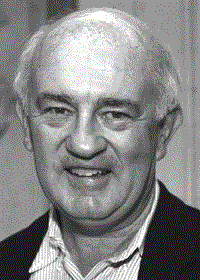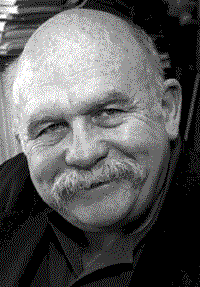
|
|
Lynn R. Sykes
|

|
|
Walter Pitman, III
|
Three scientists whose work during the 1960s helped establish geology's unifying theory of plate tectonics will jointly receive the 2000 G. Unger Vetlesen Prize Monday, Jan. 24 at a ceremony in the Low Memorial Library Rotunda.
William Jason Morgan of Princeton University, and Walter Pitman, III and Lynn R. Sykes of Columbia's Lamont-Doherty Earth Observatory will share in one of earth science's premier honors, each receiving a commemorative gold medal and a third of the $100,000 in prize money. Columbia President George Rupp will make the presentations during a black-tie dinner.
The Vetlesen Prize, which recognizes "achievement in the sciences resulting in a clearer understanding of the earth, its history or its relation to the universe," is awarded by the Trustees of Columbia in association with the Georg Unger Vetlesen Foundation. This year, in honor of Lamont-Doherty's 50th anniversary and the new millennium, the selection committee chose to highlight the revolutionary importance of plate-tectonic theory by recognizing three of its key architects.
Dr. Morgan published a landmark paper that established the kinematic framework for plate tectonics. He was also first to recognize the presence and important implications of the mid-plate volcanic "hotspots" that create island chains like Hawaii, and co-authored an important work deciphering the complex interactions that result when three tectonic plates meet at a triple-junction.
Dr. Morgan has spent his entire career at Princeton University, where he received his Ph.D. in physics, but soon followed his interests into the earth sciences. Now a long-time professor of geophysics, he has paid particular attention in recent years to enriching undergraduate education at Princeton by teaching a popular introductory course that attracts students to earth science. Among his many honors, Dr. Morgan has been awarded the Japan Prize, as well as the Walter Bucher and Maurice Ewing Medals of the American Geophysical Union. He is also a member of the National Academy of Sciences and a foreign associate of the French Academy of Sciences.
Dr. Pitman was instrumental in interpreting the pattern of marine magnetic anomalies detected around mid-ocean ridges as indicative of active seafloor spreading, thus unlocking the "Rosetta Stone" of continental drift and plate-tectonic theory. He discovered the first matched transoceanic magnetic profile that proved the reality of plate generation and motion.
After initially embarking on a career in electrical engineering, Dr. Pitman switched to earth science as a graduate student in oceanography at Columbia in 1960, and stayed on to make a career of it at Lamont-Doherty. Now a senior scientist emeritus, his research interests have expanded to include theoretical geomorphology and tectonics, with particular emphasis on unraveling the history, causes and consequences of changing sea levels. He recently co-authored the much-heralded book Noah's Flood, and is an outspoken proponent multidisciplinary research. Dr. Pitman currently co-teaches a course on environmental science for future policy makers at Columbia's School of International and Public Affairs. He is a Fellow of both the Geological Society of America and the American Geophysical Union, which has awarded him its Maurice Ewing Medal. Dr. Pitman has also received the Society for Sedimentary Geology's Francis Shepard Medal, and the Alexander Agassiz Medal of the National Academy of Sciences.
Dr. Sykes contributed significantly to the application of seismology in formulating and refining plate tectonics. He proved the importance of mid-ocean ridge transform faults in accommodating plate motion on a spherical earth, and laid the groundwork for deciphering plate motion from earthquake focal mechanisms and the precise location of epicenters at mid-ocean ridges, transform faults and deep-sea trenches. He co-authored "Seismology and the New Global Tectonics" in 1968, which demonstrated how much of existing seismological data could be explained in terms of plate-tectonic theory.
Dr. Sykes has also made his career at Columbia and Lamont-Doherty, where he is Higgins Professor of Earth and Environmental Sciences. Firmly committed to the application of basic research to societal needs, he now concentrates on earthquake forecasting and prediction, the seismic character of tectonic plate subduction, and the seismological verification of underground nuclear test-ban treaties. Dr. Sykes is a member of the National Academy of Sciences and the American Academy of Arts and Sciences, and a Fellow of the American Geophysical Union, the Geological Society of America, the Geological Society of London and the American Association for the Advancement of Science. He has held both Sloan and Guggenheim fellowships, and has received AGU's Macelwane and Bucher awards, as well as the Medal of the Seismological Society of America. The Federation of American Scientists presented him its Public Service Award for working to revive scientific and public interest in a comprehensive nuclear test ban treaty. Dr. Sykes has testified before Congress six times as an expert on nuclear test verification, and teaches a popular undergraduate course on natural disasters and hazards.
The Vetlesen Prize was established in 1959 to "rank in dignity and significance with the Nobel prizes," which do not recognize achievement in the earth sciences. Past winners include Lamont-Doherty founder Maurice Ewing (1960), Sir Harold Jeffreys of Great Britain and Felix Andries Vening Meinesz of the Netherlands (1962), Pentti Eelis Eskola of Finland and Arthur Holmes of Great Britain (1964), Jan Hendrik Oort of the Netherlands (1966), Francis Birch of Harvard University and Sir Edward Bullard of Great Britain (1968), Allan V. Cox of Stanford University, Richard D. Doell of the U.S. Geological Survey and S. Keith Runcorn of Great Britain (1970), William Fowler of the California Institute of Technology (1973), Chaim Leib Pekeris of Israel (1974), plate tectonics founding father J. Tuzo Wilson of Canada (1978), M. King Hubbert of the U.S.G.S. (1981), Wallace Broecker of Columbia and Harmon Craig of the Scripps Institute of Oceanography (1987), Walter Munk of Scripps (1993), and Robert Dickinson of the University of Arizona and John Imbrie of Brown University (1996).
Georg Unger Vetlesen was a native of Oslo Norway who emigrated to the U.S. as a young man in 1916 after earning degrees in naval architecture and mechanical engineering at the Imperial Institute of London. Despite becoming a very successful shipbuilder during the 1920s and 30s, Vetlesen joined the U.S. Navy during World War II as a Commander stationed with the Special Forces in London, where he fought in support of the Norwegian resistance. After the war, he served as president and chairman of the American company representing the transatlantic Norwegian-American Line, and later co-founded Scandinavian Airlines System, Inc.
The Vetlesen Foundation has been, and continues to be a major benefactor to Columbia. The family's personal yacht, a 202-foot schooner named Vema, was acquired by the university in 1953 and converted to use as an ocean-going research vessel. Over the next 28 years it became the first research ship to log over a million miles surveying the world's oceans, in the process producing much of the data used by Morgan, Pitman and Sykes in their groundbreaking work on plate tectonics.
The theory of plate tectonics has truly revolutionized the study of the earth's crust and deep interior, providing a cohesive framework for investigating and understanding the formation of mountains, volcanoes, ocean basins, mid-ocean ridges and deep-sea trenches, the configurations of continents and oceans in the geologic past, the evolution of both climate and life, and the distribution and concentration of petroleum and other natural resources.
"The development of plate-tectonic theory certainly warrants a Nobel Prize," said Dr. Marcia McNutt, president-elect of the American Geophysical Union. "There is no doubt that it ranks as one of the top ten scientific accomplishments of the second half of the 20th Century."
|
